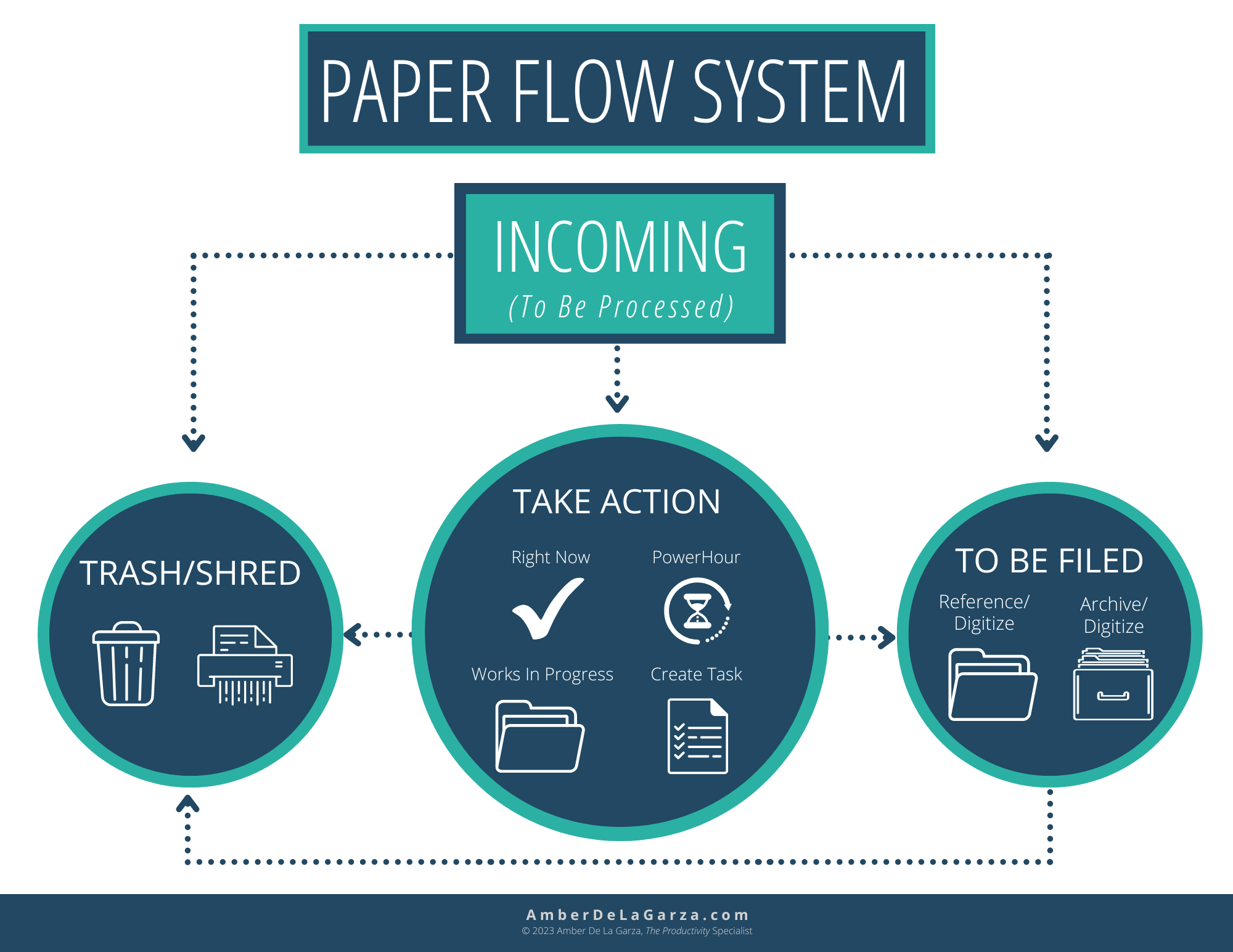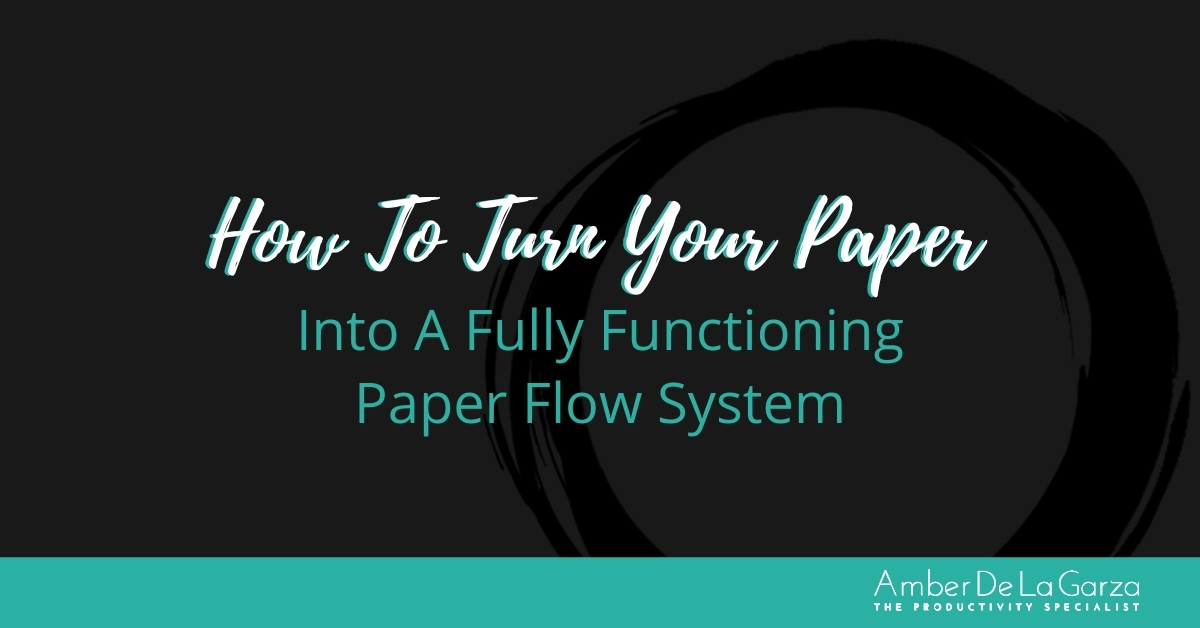The idea that our offices will soon become paperless has been a dream for many of us for many years. The truth is we are far from a completely paperless office anytime soon. So the question becomes, “How can we manage all that paper?” Paper can overtake our offices so much that it creates physical and mental clutter which are big-time enemies of focus. With stacks of papers all around to distract you from the task at hand, it is nearly impossible to work at your optimal productivity level.
Paper is challenging because it’s a tangible object that takes up space and multiplies at what feels like a constant speed, making it hard to keep up with. My top technique to conquer your paper flow involves two steps: first create a system for your paper and then maintain your paper system. Creating a paper flow system involves designing a process for every paper that makes its way into your office. Paper is often overlooked as a priority because there are always more important tasks to accomplish than filing or organizing documents, but the truth is without the ability to find documents efficiently when they’re needed or focus on the task at hand, you are wasting even more valuable time. In fact, the National Association of Professional Organizers reports we spend an entire year of our lives looking for lost items! Creating and maintaining an efficient paper flow system is an investment in constructing an environment that supports your productivity.
Creating Your Paper Flow System
Let’s talk about your inbox. All incoming documents need to be processed. Processing paper as opposed to shuffling through papers requires you to make a decision as to what to do next with each paper. For most people this is where the paper flow generally stops and is the reason why documents pile up on your desk or shelf. Immediately choose which category each paper you touch falls into between Trash/Shred, To Be Filed, or Take Action. That is the first step to creating a solid paper flow system and is the easiest.
Trash / Shred
This category is the easiest to maintain. If you do not need to take action on a paper and will never need to reference it again, get rid of it by Trashing or Shredding it. Shred it if it contains personal information or Trash it if it does not. Place a trash can and shredder (or box for shredding) in locations where they are easily accessible from your desk. This will enable you to simply and quickly Trash or Shred unneeded documents.
To Be Filed
If there's a chance you will need to reference a paper in the future but it does not require you taking any action on it now, drop it in a To Be Filed folder inside a vertical magazine holder on or near your desk. Each week or month when it is time to complete your filing (you will have scheduled a recurring task in your task management system), go through the folder and file away each paper as either an Archive or Reference document. If you're like me and run a paperless business or if that's a goal of yours, scan your Archive and Reference documents, save them digitally, then Trash/Shred the papers.
- Archive – Keep important papers you most likely will not need to reference in the future conveniently organized in files far from your desk. e.g., Save seven years of tax documents in your Archives files just in case you are audited. Alternatively, digitize them.
- Reference – File papers you likely will need to reference at some point close to you for quick filing and easy access. Keeping them within an arm’s reach of sitting or standing at your desk is best. e.g., Save industry resource materials in your Reference files in a magazine holder near your desk so you can access them quickly when they’re needed. Alternatively, digitize them.

Take Action
If a paper requires you to take action on it, whether it is a bill that needs to be paid, a project that needs to be worked on, or a phone call that needs to be made, consider it a Take Action paper which will fall into one of four subcategories: Right Now, Power Hour, Works In Progress, or Create Task.
- Right Now – If a paper requires your immediate attention otherwise you'd need to put out a fire later, complete whatever action it requires right now if time allows. Otherwise, Create A Task for it (see Create A Task below) and schedule it to be done as soon as possible. Send the contract, make the call, mail the payment, or find the reference document. Whatever the document is, take action on it right away. After you have completed the task, decide whether you need to then Trash/Shred the paper or drop it in your To Be Filed folder. Do not let the paper become additional clutter.
- Power Hour – If a paper does not require your immediate attention but calls for a doing task that will take less than two minutes to complete, perhaps a task like paying a bill, making a doctor's appointment, or responding to a non-urgent email, add it a Power Hour folder inside a vertical magazine holder on or near your desk. Then, during your weekly scheduled Power Hour, open that folder and complete all of the small, batched tasks you had placed in it in rapid succession with the utmost efficiency. After you complete each task, Trash/Shred its related paper or add it to your To Be Filed folder.
- Works In Progress (WIP) – If a paper is related to or a resource for a project you are currently working on and you will likely need to reference it in the near future, don't file it away as a Reference document. Instead, put the paper in a folder labeled Works In Progress or WIP and add it to the vertical magazine holder on or near your desk for easy access. If you are currently working on a few projects that have a lot of paperwork you must reference frequently, use a second vertical magazine holder and a different folder for each project, labeling the magazine holder Works In Progress or WIP and labeling the folders by each different project's name. After finishing each project, Trash/Shred its related paper or move them to your To Be Filed folder.
- Create Task – If a paper requires you to take an action on it that will take longer than two minutes, is unrelated to a project you're currently working on, and does not have to be done right now, Create A Task for it in your task list. Then, schedule that task on your calendar. Finally, place that paper in a Pending Tasks folder inside the vertical magazine holder on or near your desk. When it comes time to complete that task, its related paperwork will be easy to find and quickly accessible. After completing each task, Trash/Shred the paper or drop it in your To Be Filed folder.
Maintaining Your Paper Flow System
No matter how efficient the paper flow system you create is, if you don’t maintain it, you will likely find yourself on an organizing yo-yo diet consisting of spring cleaning your stacks of paper, just to let them stack back up over and over again. The key to long-term success is to commit to system maintenance.
Utilize the following eight recommendations to consistently maintain your paper flow system.
Don’t Shuffle Paper – If you shuffle through your papers while attempting to sort them you are just avoiding making a decision as to what to do with each document. Touch each paper once and make a decision.
Quickly Make Decisions – It’s only paper! Often times we freeze and refrain from taking action because we fear making the wrong decision. If the decision is too difficult to make quickly, postpone it by making the paper a Power Hour document and come back to it then when you have the time to better assess it.
Don’t Over-Organize – Filing documents into folders is for the sole purpose of retrieving them quickly when and if they’re needed. Creating so many folders that each of them only has a few or even one paper in it only complicates the filing and retrieval process. Less is more. This applies to digital organization as well. Organize sensibly.
Trust Your Instincts – When you originally touch each paper, what is your first thought? Does a certain word come to mind? For example, if I pick up my automobile purchase contract, do I first think Auto, Car, or Dodge Charger? When you go to retrieve that document or file a similar document away again, you will likely think of that word then, too. You could create one file for Automobile if you have one car or a different file for each of your vehicles if you have several, labeling them according to their make and model if your brain naturally thinks along those lines.
Don’t Hoard Paper – Many documents are not even worth the time to file (think junk or unsolicited mail). When in doubt, ask yourself the following questions:
- When was the last time I needed this type of document?
- If I needed this document again could I get a copy somewhere else?
- Do I need to be the person to keep this document?
- Might there be any consequences if I don’t keep it?
Mark Purge Dates – On each folder you file away as an Archive, write the date when its contents can be purged. Perhaps you need to keep bank statements for seven years. Write whatever date it will be in seven years on the folder so you can Trash/Shred those documents without hesitation when you do your annual purge seven years from now.
Every Document Needs A Home – Whether you use a file folder, drawer, box, binder, vertical magazine holder, or wire step organizational rack, every single paper in your office needs a home and your desktop does not qualify. Create homes for every type of paper that could make its way into your office and get in the habit of putting each and every one where it belongs according to the paper flow system you create instead of letting them pile up and create clutter.
Utilize Single-Tab Folders – Do not overcomplicate your filing system by using multiple-tab file folders. At first glance, using three-tab or five-tab folders might make sense because their design increases visibility of each folder. However, when you add or remove folders from your files, the multiple tabs no longer make sense and folders consequentially wind up hiding behind each other. Instead, use only single-tab folders such as center position folders for your entire filing system. It makes sorting through and accessing documents simpler and maintaining organized files easier.
Creating a sound paper flow system may take some trial and error on your part. After all, you may have gotten in the habit of letting stacks of papers build up on your desk and habits, especially those due to lack of action, are hard to break. The benefits will be well worth the effort, however, as you decrease your paper clutter, increase your ability to stay focused, and find needed documents with ease. Studies show that some executives will pick up a single piece of paper from their desk thirty or forty times before acting on it, (Michael F. Woolery, Seize the Day). Don’t let such bad habits hold you back from working at your maximum productivity level and achieving more in your business.


